From a manuscript by Jean Harrod in the Society’s archives, with minor amendments (BF 19/15h)
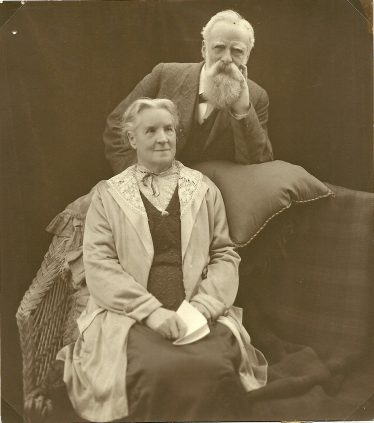
Henry and Susan Salisbury, c.1910?
One of the picturesque cottages in Batchelors Row, since replaced by a supermarket [in the 1960s], was formerly the home of James Salisbury. He was a retired meat-salesman of an amiable and generous nature, and popular with the children because of his ‘singing blackbird’ which he had trained to whistle a catchy hymn-tune of the day. He had moved from Buckinghamshire on his retirement in 1863, doubtless to be near his sons James (who lived at Limbrick Hall) and Henry, newly wed to Susan Hawes of Markyate on March 10 that year. Susan’s brother Cecil also moved to Harpenden for it was he who founded Hawes and Harris, the stained glass works in Park Stables.
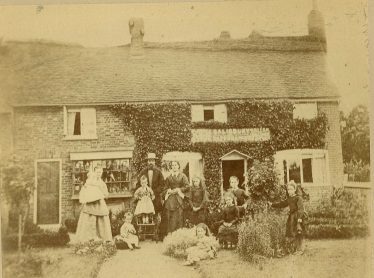
Henry Salisbury and his family outide their home in Leyton Road, c.1876
Henry and Susan settled in a little house facing the Common. It consisted of two old cottages thrown into one (by 1974 The Inn on the Green). It had low ceilings and doorways, dark passages, and worm-eaten floors, but as a student visitor wrote “The rooms were pleasant places with cosy nooks and an air of homely comfort” (Methodist Recorder). The living room had an Adam’s over-mantel and a mirror reflecting the scrolls and flowers of the papered walls; about the room were glass vases hung with prismatic dangles. In another front room Henry opened a small ironmongery shop, and he ran a builder’s yard behind the house. Soon he built up a flourishing business for he was quickly known to be absolutely trustworthy and of a friendly disposition. In the 1871 census he is described as aged 32, a master plumber, glazer and painter employing six men. Already he and Susan had six children, three at school and three younger, the youngest being Frederick two months old. They kept one domestic servant aged 19 years. By 1884 they had six more children. Fortunately the garden at the back was long and rambling and had a summer house perched up in the branches of a huge tree. In turn they attended the village school [the National school, St Nicholas], except for Frank, by this time a big lad in knickerbockers, who was too delicate to go to school until he was twelve years old. Then he was “sent now and then to Mr Henshaw’s nearby (The British School at Park Hall] and dreaded it … finding myself so backward. My sister Emmie … a student teacher … took me in hand at home” (Portrait and Pageant, Frank O Salisbury, 1944). To give him occupation in the healthy village air his father had provided him with a plot of land in the orchard and another in a field on which he grew wheat and mangolds, having made himself a drilling machine. In the orchard plot he kept an ewe and two lambs.
As in so many Victorian households, the day started with family prayers. Frank wrote “It is a marvel to me that my father could keep it up for so long with five boys always longing to get to their games, for almost before the Amen … there would be a regular stampede to the door. When father was away, mother took prayers. One morning as she was praying most diligently she saw a mouse run under her chair, and after a little squeal she finished the prayer standing on the chair.” Henry Salisbury taught his family not by stern doctrine or rigid rules: “he believed example is better than precept – simplicity with a quiet demeanour. If we transgressed, the sadness in his eye was sufficient punishment.” But if any of them were very naughty they were sent into the orchard to choose a stick from the filbert bushes which each child thought fitting to the gravity of the offence. “This mournful pilgrimage generally ended in true repentance and brought us a happy reprieve.” Henry was a very “simple and loveable character and taught his children the joy of doing things well and the value of time”.
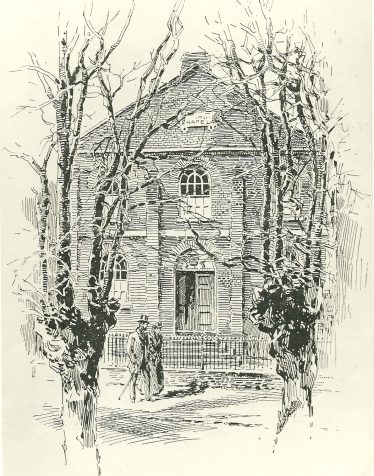
The first Methodist Chapel, Leyton Road, built in 1839
From the day of their marriage and in spite of the demands of a large family both Henry and Susan worked tirelessly in the old Leyton Road Wesleyan chapel, and as soon as they were old enough the children played active roles too. At James’ suggestion the Band of Hope was started in 1877 and proved immensely popular. Susie and Eustace were enthusiastic supporters of the Wesley Guild. Susie became a lively and much-sought-after speaker. On one occasion at the Guild she dressed as a Norwegian peasant girl and told about her midsummer days in Norway and illustrated her talk by a lime-light lantern.
In time Henry held every office in the chapel and he remained Superintendent for forty seven years, being known as the “Grand Old Man of Harpenden Wesleyan Sunday School”. His flowing beard made him look quite patriarchal.
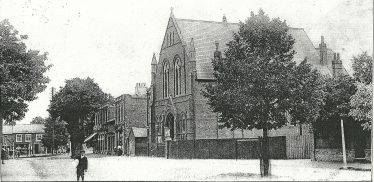
The second Methodist Chapel, Leyton Road, dedicated in 1886
When the old chapel became too small the members struggled for a long time to raise money for a larger one. This they successfully opened on the same site in 1886 and Henry Salisbury laid one of the four commemoration stones. In 1894 at his residence he was presented with an illuminated address on vellum by the congregation of Leyton Road chapel in appreciation of his services for more than a quarter of a century.
In the issue of April 8, 1890 the St Albans Times reported the first marriage in “the pretty new Wesleyan Chapel”, that of the eldest daughter Sarah Lilian and Mr Henry Woods of Galway. Such was the family’s esteem that at Emily’s wedding three years later the Rev. F Greeves DD, President of the Wesleyan Methodist Conference, came to conduct the ceremony and special music was provided by the choir under the guidance of Miss Walker and […illegible] Claridge sang “The voice that breathed o’er Eden”. When it was Annie’s turn to be married, a garden party was planned but rain prevented it and instead “a special tent was erected for ‘dejeuner’, the decorations being exceedingly charming” (St Albans Times, June 10, 1896). Then in 1901 Cecilia married Owen Green and there were so many guests that the reception was held in the Public Hall and Hilda, the youngest of the family, aged sixteen, was one of the bridesmaids.
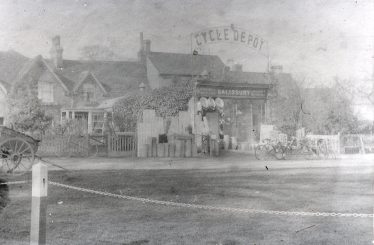
The Salisbury ‘Cycle Depot’, Leyton Road, c.1900
As the years went by in this lively energetic home, business flourished and soon outgrew the shop in the little room, and Henry erected a corrugated iron building in front of it. Edgar officially entered the business and ran the shop, Susie worked in the office in the room at the back and Eustace still ran the builder’s yard, later running a Fine Arts business there also. James, the eldest son, had opened a Stained Glass and Art Decoration Studio in Alma Road, St Albans in 1886 and Frank was apprenticed to him for three years before winning a Royal Academy Scholarship and eventually becoming a famous artist. The loveable Fred, so popular in the village, had unfortunately succumbed to consumption and gone to South Africa for the last three years in the vain hope of recovery. He died in 1897. The next year the Methodist Recorder printed “This beautiful suburban village is rapidly growing and our church is keeping abreast of the times. It reported that the scheme for the renovation and extension of the church is complete and that Henry Salisbury and his family have given two stained glass windows in memory of Frederick. These were later removed to the Lecture Hall of the High Street Methodist Church.
Henry long continued to enjoy working with his men and was loved and respected by them all. In 1901 he fell from a ladder over a doorway at H J Hodgson’s residence, the Welcombe, but was in bed only a few days. He had a share in the residential development of Harpenden particularly in the building of an estate on what had been Manland Common. He used to pedal up there on his tricycle, with an apprentice lad Arthur Chalkley who was riding on the back to help him “do the measuring”. He had one of the first cars about here: he had it sent up from the south coast. It was a second-hand one.

Kingston House, built and opened in 1912
With business prospering, Henry moved in 1906 to Arden House, 1 Arden Grove – since demolished to form Harding Parade. And when Dr Kingston’s house next to The George came up for sale in 1912, he took the opportunity to move his business to Harpenden High Street. He demolished the old, ivy-covered house, and designed and built Kingston House within five weeks of obtaining planning permission (he was on the Council), so that he could open his new store on 12 December 1912.
Luton News tribute
Henry long outlived Queen Victoria’s reign, and when he died at the age of eighty four The Luton News, January 1923, mentioned not only his work as a builder and decorator, but reported that: “He took an active part in local affairs being a member of the old Parish Council and afterwards of the Urban District Council. He was Chairman of the Gas Company for many years. … The role of Methodism in Harpenden owes a very great debt to Henry Salisbury”.

Family tree of Henry Salisbury’s descendents

No Comments
Add a comment about this page